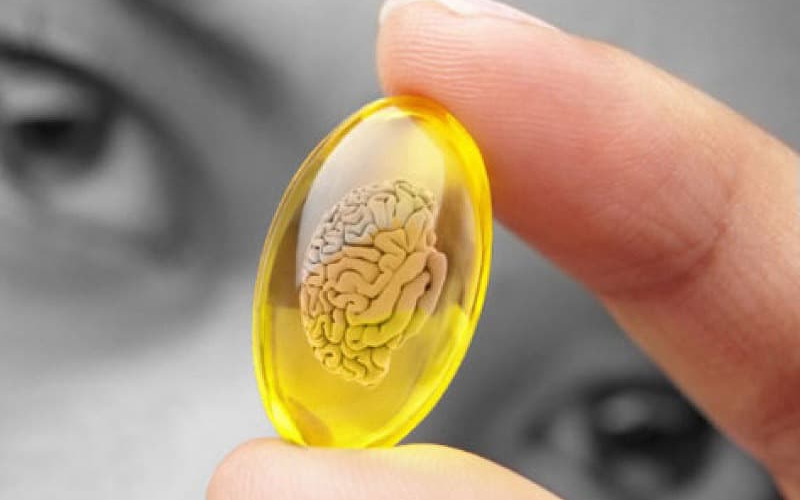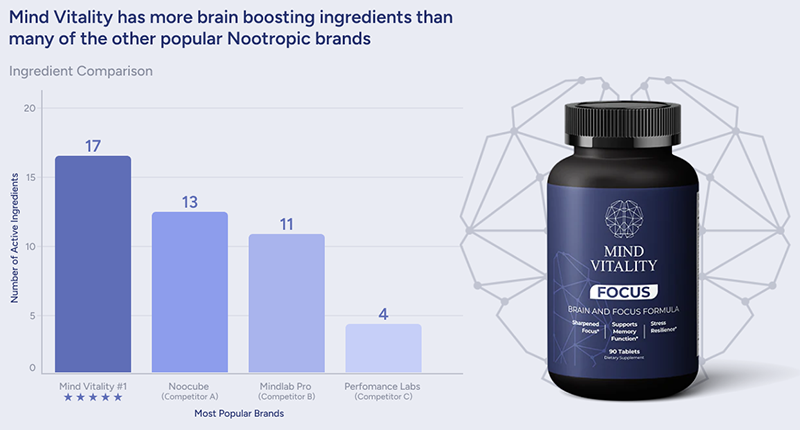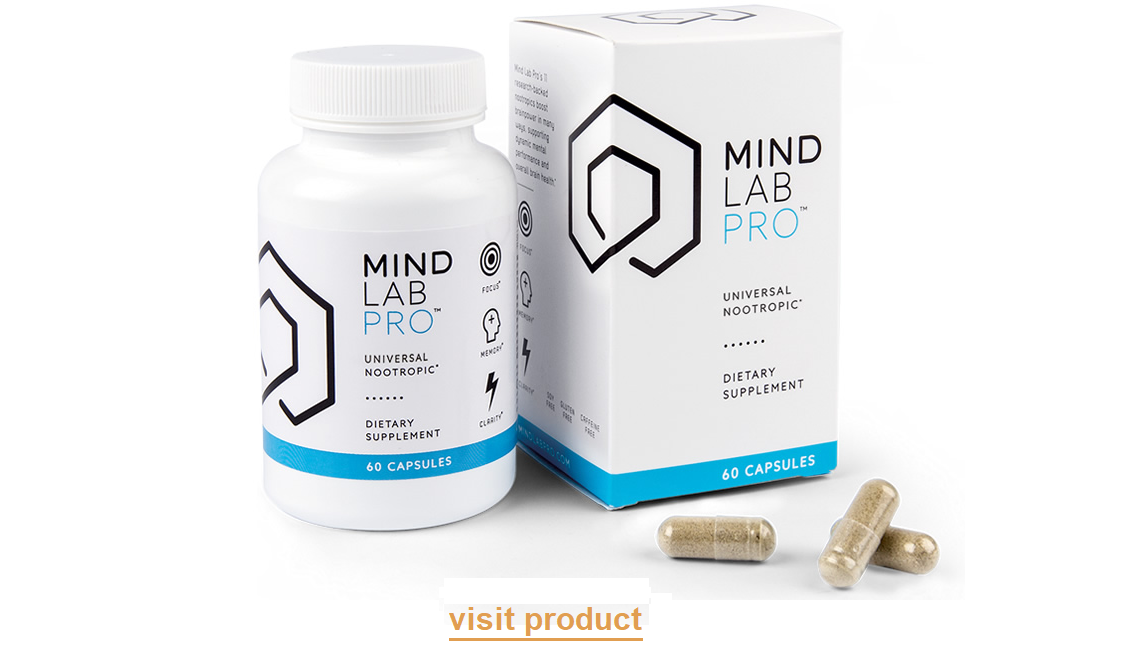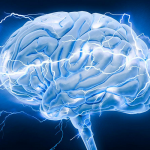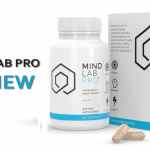Nootropics — brain-enhancing compounds — come in natural form (like some herbs and amino acids) and synthetic form (like lab-created drugs in the racetam family). Of all the synthetic nootropics, Noopept is currently the most popular. Noopept improves several cognitive functions including memory, learning, and focus, and additionally helps some people cope with stress and anxiety.
Contents
What Is Noopept?
Nootropics are a category of supplements or drugs that are known to have cognitive-enhancing effects — thus the alternate name of smart drugs. Noopept is a synthetic (man-made) nootropic. It’s capitalized because it is a brand name for a compound called N-phenylacetyl-L-prolylglycine ethyl ester. After looking at the generic name, you now know why everyone (with the exception of chemists) prefers to refer to the drug by the brand name.
Noopept was first synthesized in Russia in 1996, and is often grouped in with the racetam family of synthetic nootropics — but that’s erroneous. Noopept does have some molecular structure similarities to racetams, but it doesn’t include something called a pyrollidine nucleus — a requirement to be considered a racetam.
Noopept is considered powerful, but it doesn’t produce powerful stimulatory effects — it’s not considered a stimulant. And it doesn’t provide any psychostimulation or euphoria — Noopept doesn’t get you “high.” While Noopept (and other synthetic nootropics) are often referred to as smart drugs, Noopept is not a drug in the sense of being a prescription medication. In the United States Noopept can be legally purchased and taken as a supplement without prescription.
Noopept Is Based On Cycloprolylglycine
A neuropeptide is a small molecule that enables neurons (brain cells) to communicate with one another. A neuropeptide consists of a chain of relatively few amino acids (from three up to 40), so neuropeptides are said to be protein-like. These chemical messenger molecules act as neurotransmitters to perform specific functions to influence activities in the body and the brain.
Cycloprolylglycine, or CPG, is a neuropeptide that promotes the activation of brain derived neurotrophic factor, or BDNF. BDNF is a protein important to neuron growth and health, and plays a vital role in learning and memory (more about BDNF ahead in the Noopept Increases NGF and BDNF section).
Researchers theorized that a nootropic based on cycloprolylglycine would naturally have effects similar to cycloprolylglycine. What they came up with was Noopept. Noopept is a prodrug to cycloprolylglycine. A drug is a medication that is already pharmacologically active, while a prodrug is a biologically inactive compound that the body metabolizes to produce a drug. In short, Noopept gets converted into cycloprolylglycine by the body.
Noopept Is Similar to the Racetam Piracetam
Racetams are a family of synthetic nootropics. Developed in 1964, piracetam was the first racetam. Noopept isn’t a racetam, but its molecular structure is similar, and its effects on cognition are similar, so it’s often mistakenly referred to as a racetam.
The main difference between piracetam and Noopept is that Noopept is much more potent than piracetam. It’s important to understand, though, that when talking about being more potent this mainly refers to being more potent by weight. If someone says Noopept is 100 times as potent than piracetam, they don’t mean it has 100 times the brain-enhancing effects of piracetam. Instead they mean you’d need to take 100 times as much piracetam by weight in order to achieve the same neurological benefits.
Both Noopept and piracetam improve mood, reasoning, focus, memory, and other factors related to mental processing and cognitive ability. The fact that you need to buy, and take, much more piracetam, and Noopept effects tend to last a little longer, means in the battle of Noopept vs piracetam, Noopept seems to be the clear winner.

How Noopept Works
The brain health benefits of Noopept come primarily from two mechanisms of this drug. Noopept increases the release of the brain factors NGF and BDNF, and it also increases the levels of the neurotransmitter acetylcholine.
Noopept Increases NGF and BDNF
Nerve growth factor, or NGF, is a protein critical to the maintenance, growth, and life of brain cells. NGF is also crucial to neurogenesis — the process of creating new neurons, or brain cells.
Neurogenesis enhances the performance of neural networks — groups of neurons that fire together, creating electrochemical pathways. This improving and restructuring of neural networks, or neuroplasticity, is associated with enhancing just about every area of cognition. Noopept stimulates the expression (the “turning on”) of NGF, thereby helping along neurogenesis and neuroplasticity.
Noopept is also known to increase the levels of another cognition-related chemical important to brain function: brain-derived neurotrophic factor, or BDNF. Like NGF, BDNF plays important roles in the growth, maintenance, and neurogenesis of neurons. To some extent BDNF and NGF operate in different parts of the brain, though there is overlap.
Increased BDNF levels increases the density of neurons, which improves several cognitive functions, including learning, focus, memory, and verbal fluency. Research shows that increased BDNF improves brain functions, and that Noopept significantly increases BDNF in the brain.
Noopept Increases Acetylcholine Levels
In addition to increasing NGF and BDNF levels, Noopept increases levels of another chemical important to cognition: acetylcholine.
The cell walls of neurons have receptors that allow specific neurotransmitter molecules to attach to the wall and pass information into cells. A receptor basically acts as a gateway that lets specific neurotransmitters signal a neuron to act in some manner.
Some neurons have acetylcholine receptors that allow the cell to “listen” to acetylcholine. Acetylcholine is a neurotransmitter that plays a key role in learning, attention, motivation, and focus. Studies show that Noopept increases the density of acetylcholine receptors, encouraging the production of more acetylcholine to match the demands of these “acetylcholine-hungry” neurons.
Cognitive Benefits of Noopept
Noopept brings about the release of at least three important cognition-related chemicals: NGF, BDNF, and acetylcholine. If you think that sounds like something that would result in positive effects on a variety of cognitive processes, you’d be correct. Supplementing with Noopept may provide benefits in some or all of the following areas of cognition:
- Concentration, focus, and attention
- Neuroplasticity (development of new brain cells)
- Memory function
- Neuroprotection (general brain cell health)
- Anxiety lessening
- Learning
Noopept Enhances Memory and Learning
Piracetam, the racetam Noopept is most often compared to, improves memory formation. This so-called working memory function is key to efficient learning. Noopept does improves memory formation as well. Noopept, though, enhances a couple of additional very important memory-related functions that piracetam is not known for — memory consolidation and retrieval.
Your brain creates and stores memories. But how and where memories are stored is important to the quick and accurate retrieval of those memories. Storing memories is important, but you want to be able to efficiently use the knowledge stored in your brain’s memory maps.
Memory consolidation has to do with turning short-term memories into long-term memories. You can think of Noopept as streamlining the act of signals being processed as they turn from stimuli to memories. Memories get better organized in the brain, and this improved consolidation later leads to improved retrieval — the better organization allows for better retrieval when the time comes for memory recall.
Use of Noopept can improve your memory and recall, meaning you may find improvements in recalling places, names, and even trivial facts you has long since assumed you’ve forgotten.
Noopept as a Study Drug
Noopept’s ability to enhance memory and learning — especially its power to improve consolidation and retrieval — have made it a popular study drug. There are a few other popular study drugs, most notably Adderall and Modafinil.
Adderall is a prescription medication used to treat attention deficit hyperactivity disorder (ADHD) and the sleeping disorder narcolepsy. Adderall is considered a nootropic because it has brain-enhancing properties. Adderall is a prescription drug, and amphetamine, and can be addictive. Noopept, on the other hand, shares none of these traits. Because of that, in an Adderall vs Noopept comparison for studying, Noopept is considered the preferred drug.
Modafinil is another popular study drug. Like Adderall, Modafinil is used for the treatment of narcolepsy and other sleep disorders but also provides nootropic benefits. And also like Adderall, Modafinil is a powerful stimulant that is available only by prescription. Modafinil carries a risk of adverse psychiatric reactions. For these reasons, in a Modafinil vs Noopept comparison as the preferred study drug, Noopept again seems to be the winner.

Noopept Improves Focus, Attention, and Concentration
Noopept promotes clear-headedness, attention, and focus. The mechanism to improving these cognitive functions may lie in Noopept’s ability to influence brain waves — especially alpha and beta brain waves.
Brain waves are oscillations of minute voltages in the brain that are produced by synchronized electrical pulses resulting from neurons (brain cells) communicating with one another. Brain waves occur at several frequencies. That is, some are slower and some are faster.
Alpha brain waves have a low frequency — they’re slow waves produced when awake but relaxed. Noopept increases alpha waves, which can lead to calmness and a state of increased creativity. Noopept also increases beta brain waves, which are of a little higher frequency (a little faster). Beta waves occur while awake and engaged and focused on decision making and tasks. This increase in beta brain waves may be responsible for the increased focus and concentration that accompanies the taking of Noopept.
For many people the improved focus goes beyond a learning, or cognitive, focus. Noopept has anxiolytic properties, meaning it can help reduce anxiety. With Noopept this is especially true for social anxiety.
Many people with social anxiety have problems focusing on conversations or “reading” people. Noopept’s ability to increase focus can extend to social settings, and make a person a better listener and conversationalist, which goes a long way towards feeling more comfortable when in a group of unfamiliar people. Noopept increases brain-derived neurotrophic factor (BDNF). BDNF plays a role in verbal fluency, so this too may be a reason some people who take Noopept become more comfortable in social settings.
Noopept Has Neuroprotective Properties
Noopept has been shown to act as a powerful neuroprotectant — a compound that can protect and extend the life of brain cells. This shouldn’t be surprising, as Noopept was specifically developed as a potential treatment for cognitive disorders.
In Russia, where this nootropic was developed, Noopept has been successfully used in the treatment of a number of brain-related impairments, including age-related neurodegeneration, organic brain syndrome, and stroke.
It’s believed Noopept’s neuroprotective properties arise from a few different factors. Already mentioned is Noopept’s ability to increase levels of the cognition-related chemicals nerve growth factor (NGF) and brain-derived neurotrophic factor (BDNF). Both NGF and BDNF play crucial roles in the growth, maintenance, and neurogenesis (creation) of neurons.
Antioxidants protect cells — including brain cells — from the oxidative damage that results from an excess of free radicals — flawed molecules that get formed when a body encounters stressors or contaminants. Oxidative damage has been conclusively associated with neurodegenerative disorders such as Parkinson’s disease and Alzheimer’s disease, as well as age-related cognitive decline. Noopept is a powerful antioxidant.
Finally, Noopept is an anti-inflammatory. Inflammation is known to play a role in the decline of cognitive functions including memory, verbal learning, short-term memory, and spatial reasoning.
Noopept Dosages
One of the major selling points of Noopept is the incredibly small amount that needs to be taken to deliver its full effects. Whereas the daily dosage of the popular and somewhat similar nootropic piracetam is typically 2,000 mg to 6,000 mg, the recommended daily dosage of Noopept is 1/100th of that — just 20 mg is common. The maximum dosage of Noopept is just 40 mg per day (two doses of 20 mg each).
Some users have reported building a tolerance to Noopept after a couple of months of daily use. If you supplement with Noopept and find that over time it’s effects become less noticeable, the solution is to simply take a break — discontinue taking Noopept for a month or so, and then return to daily use. If you cycle Noopept in this manner you should be able to use this nootropic indefinitely.
Noopept Half-Life
The half-life of a drug or supplement is the time it takes for the concentration of the compound in the body to be reduced by one half (50%). A short half-life means that the compound reaches maximum concentration quickly, and the effects of the compound on the body are fast acting as well. Noopept has a very short half-life — just 20 to 50 minutes.
One common misconception regarding half-life is that if a supplement has a short half-life, the supplement’s benefits will be very short as well. That’s not always the case, and it certainly isn’t the case with Noopept. With Noopept, its half-life is not related to the duration of its actions. That’s because Noopept is a prodrug to the chemical cycloprolylglycine — the body metabolizes Noopept to produce cycloprolylglycine. It is then cycloprolylglycine that is responsible for much of the brain-enhancement attributed to Noopept. So while Noopept itself won’t be in your system for long, the chemical it turns into will be. See this post’s Noopept Is Based On Cycloprolylglycine section for more on cycloprolylglycine.
Noopept Stacks
Noopept is often taken on its own, but if you’re into nootropic stacking (combing two or more nootropics), Noopept is a great candidate to be part of a stack.
Noopept and Choline Stack
One of the ways Noopept enhances cognition functions is by promoting an increase in acetylcholine. This neurotransmitter plays a big part in attention, learning, memory, focus and mood. Acetylcholine is synthesized from the nutrient choline. The body makes some choline, but not much — the majority of the choline in a person’s system comes from diet.
To help your body produce the extra acetylcholine Noopept will be attempting to release, you’ll want to stack a choline supplement with Noopept. Taking choline will also eliminate the possibility of experiencing what some people refer to as the Noopept headache — a headache a person can experience if the body is depleted of choline due to all available choline being used to produce acetylcholine.
Choline supplements are available in a few different forms. The two best forms are CDP choline (also called citicoline) and Alpha GPC. Optimal Choline Complex from Pure Nootropics is a good choice for a choline supplement because it is a combination of both these preferred forms of choline.
Noopept, Phenylpiracetam, and Choline Stack
Racetams are a group of synthetic nootropics. The first racetam that was developed is called piracetam. Piracetam has always been a popular racetam, but recently phenylpiracetam — a racetam derived from piracetam — might be considered the leader in terms of racetams.
Noopept and phenylpiracetam are similar in that they are both synthetic nootropics, affect neurotransmitters, and boost a variety of cognitive processes. Phenylpiracetam, however, primarily affects the neurotransmitter glutamate whereas Noopept primarily affects the neurotransmitter acetylcholine. Their similarities, along with their different modes of operating, make for great synergistic benefits when the two are stacked together.
It’s a good idea to stack choline along with Noopept and phenylpiracetam, for the reasons described above — choline helps your body release more acetylcholine for use by Noopept, and eliminates the mild headaches some people experience from Noopept.
Noopept and Mind Lab Pro Stack
Mind Lab Pro is a nootropic supplement that is described as a whole-brain optimizer. Mind Lab Pro acts on the six primary brain pathways — the different means by which the brain carries out its many cognitive functions. This supplement is a combination of 11 nootropics, which makes Mind Lab Pro itself a stack — a pre-formulated stack that saves you the effort of buying and combining so many individual nootropics.
It’s always a good idea to stack choline with Noopept. Because citicoline (also known as CDP-choline) is one of the 11 nootropics that make up Mind Lab Pro, there’s no need to buy a choline supplement if you choose to stack Mind Lab Pro with Noopept.
Mind Lab Pro on its own is a hugely popular and effective nootropic stack. Stacking Noopept on top of such a solid nootropic foundation can power up the already powerful Mind Lab Pro.
Conclusion
Noopept is a synthetic nootropic that isn’t in the racetam family, but has a molecular structure, and brain-enhancing effects, similar to the popular racetam piracetam. The major difference between piracetam and Noopept is potency — Noopept is at least 100 times more potent by weight. That means a single minute dose of just 20 mg per day is all you need.
Noopept improves an impressive number of cognitive functions including learning, concentration, focus, and memory, and additionally can help some people cope with stress, anxiety, and depression.


